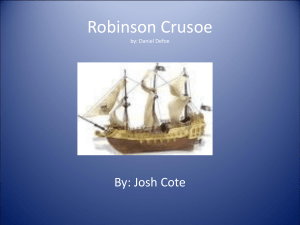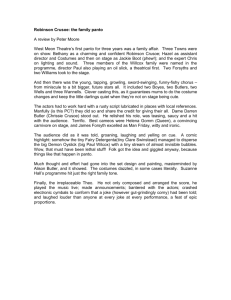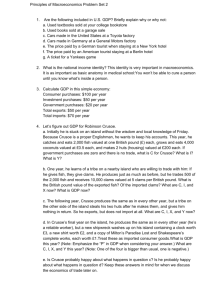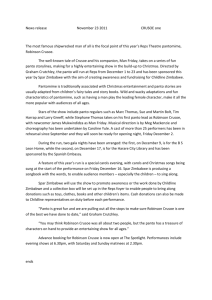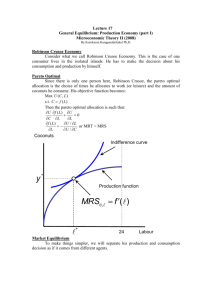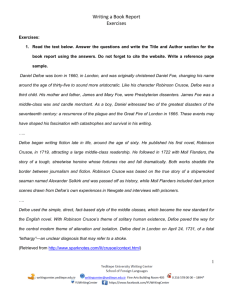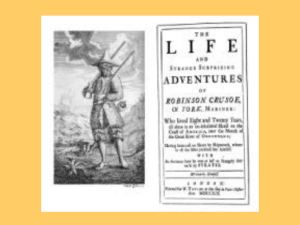Robinson Crusoe and the Island of Despair Study Guide
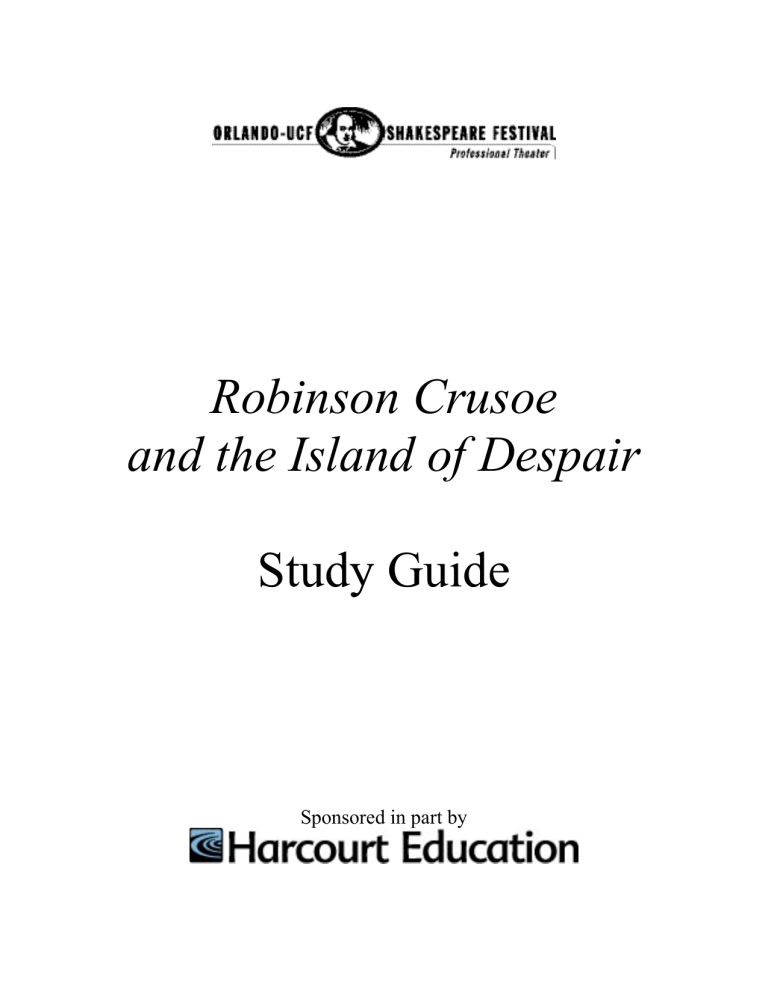
Robinson Crusoe and the Island of Despair
Study Guide
Sponsored in part by
Page 2
Page 3
Page 4
Page 5
Page 7
Table of Contents
Meet the Characters
Plot Summary
Discussion Questions
History and Influences
3 Complete Learning Plans
Meet the Characters
Robinson Crusoe - An English sailor turned plantation owner, Robinson Crusoe is shipwrecked on an island for twenty-eight years. With great ingenuity and energy, he sets out to find a way to survive.
Spanish Captain - The Captain of Crusoe's slave ship. He wants to turn back during the storm, but Crusoe won't let him abandon the voyage.
Bo'Sun (Boat Swain) – The petty officer on Crusoe’s ship in charge of the ship's rigging, anchors, cables, and deck crew.
Angel - A spirit who appears to Crusoe during his illness.
Friday - A native of South America, he is rescued from cannibals by Crusoe.
Plot Summary
Act I
The play begins on a ship; the twelfth day running from a hurricane. Eleven men and the captain fight to keep the ship together despite the increasing wind and waves. The ship's captain wants to turn back and save themselves from this ever intensifying storm, but Robinson Crusoe, an English sailor and plantation owner, demands they remain on course. The ship hits a reef off the coast of an island which pierces the side of the ship. The men drop the lifeboats and try to row for the land, but they are no match for the storm. Crusoe's body is flung against a piece of rock but he manages to make it to land before he passes out.
Crusoe awakes on the island to discover that only he has survived the storm. At first, Crusoe despairs over his situation, calling this island "the Island of Despair." However, after the first day he sees his wrecked ship off the coast and is able to find some unspoiled food and supplies.
Among the supplies are ink and paper, which become his journal, and the ship’s dog. Also discovered are bags of gold and silver. Cursoe dismisses the gold and silver because he realizes that money has no value on this island and thus is of no use to him. He takes everything of use off of the ship and creates camp for himself.
As Crusoe begins to fully realize his hopeless desertion on this island, he angrily lashes out at
God. Then it dawns on him that of the twelve men on the ship, he was the only one to survive, and in this he finds some comfort. While hunting on the island, he finds a nest of turtle eggs and eats them that evening. He gets sick from the eggs and suffers a two-week illness. During his illness he dreams of an angel who tells him to change the way he lives or he will die. He awakes feeling much better and with a new desire to persevere.
As time passes, Crusoe becomes a skilled craftsman and farmer. As his ink begins to run out he is able to write less and less. He decides to only write when monumental occasions arise, or at the end of every year to document it's highlights. Crusoe has now become very familiar with the island and has even found a pet parrot, which he calls "Poll." He teaches it to speak, so he can have someone to talk to. Ironically, he realizes how much happier he has become living on this island as opposed to the life he led in Brazil. Crusoe has also taken to reading the Bible daily, growing closer to God through passages such as "I will never, never leave thee, nor forsake thee."
Act II
Crusoe's ink has almost run out, so he rarely writes anymore for fear of not having another opportunity. However, an occasion does arise when he discovers a man's footprint in the sand.
Sometime later, he finds human bones scattered about the shore. He discovers that native cannibals occasionally visit the island to kill and eat prisoners. At first he plans to kill the savages for their abomination, but then realizes that he has no right to do so because the cannibals have not committed any crime against him.
One day while watching the cannibals, Crusoe assists a prisoner trying to escape. Crusoe names his new companion "Friday" after the day of the week he found him. He teaches him English, and soon Friday becomes Crusoe's humble and devoted servant. Crusoe and Friday make plans to leave the island, but their voyage is postponed when the cannibals return. The cannibals bring two prisoners onto the island, one of them is a white man, and the other is Friday's father.
Crusoe decides to attack the cannibals and save the prisoners. The four men begin to plan a voyage to the mainland. Then one day an English ship appears. Crusoe realizes that the sailors have mutinied and intend to maroon their captain on the island. The four men rescue the captain and regain control of the ship. The grateful captain gives Crusoe many gifts and takes them all back to England. Crusoe had spent 28 years on the island, and in 1686 he returns to Europe finding his plantation well cared for and prosperous.
Discussion Questions
1. "Let this stand as a direction that we may always find something to comfort ourselves from, and to set, in the description of good and evil, on the credit side of the account."
What do you think of this statement? Crusoe was able to find joy in the most hopeless of situations. What other people can you think of, either from history, or in your own experiences, who have overcome obstacles because of their strength of character?
2. Robinson Crusoe comes to depend on his God for guidance and companionship while he is stranded on the Island of Despair. What impression did you get from his relationship with God?
Why do you think Crusoe's spirituality became so important on the island?
3. When Crusoe found the bags of gold and silver on the ship he realized what little good they would do him on the island. Have you ever felt this way about money? Do you have any prized possessions that have no outward or monetary value? How does this make you consider the value of money and possessions?
History and Influences
Robinson Crusoe—the book
Robinson Crusoe and the Island of Despair is based on the book Robinson Crusoe by Daniel
Defoe. Most books of this time were written from a third person perspective, as if a narrator was telling the story, but Robinson Crusoe was written as if Crusoe told the story directly. Also, most books during this time were romantic in nature, meaning that at least part of the story was a love story. However, the majority of Robinson Crusoe is about Crusoe living alone on the island. Though Robinson Crusoe seemed to have none of the ingredients of a popular book, it became one of the most widely read books of all time. The book was first published on April 25,
1719 and before the end of the year, the first volume had run through four editions. Within a matter of decades, it had reached an audience as wide as any book ever written in English. No single book in the history of Western literature has generated more editions and translations
(even into languages such as Inuit, Coptic, and Maltese). The story touched so many lives because readers could relate to Crusoe. He is not a hero but a regular man. He begins as an aimless wanderer, but then overcomes extraordinary difficulties; finding hope out of the most hopeless situations.
The author of the book Robinson Crusoe—Daniel Defoe
Daniel Defoe is generally considered to be England's first true novelist. His book Robinson
Crusoe is a classic of English literature. The son of a London butcher and well educated, he was self-reliant, industrious, and possessed a strong notion of personal and moral responsibility.
Although he studied to be a Presbyterian minister, he became a merchant instead. Unfortunately, he went bankrupt in 1692 and was never entirely free from debt again.
Defoe has been called the father of modern journalism; during his lifetime he was associated with 26 periodicals. His first important publication was An Essay Upon Projects in 1698, but he started to achieve real fame with the poem The True-born Englishman in 1701. He was imprisoned for writing The Shortest Way with Dissenters in 1702, which criticized the Church.
He was nearly sixty when he turned to writing novels. In 1719, he published his famous
Robinson Crusoe , followed by two less popular sequels. Robinson Crusoe is considered by some critics to be the first true English novel. Defoe's writing is always straightforward and vivid, with an astonishing concern for detail. His other major works include Captain Singleton (1720),
Colonel Jack (1722), Roxana (1724), and A Tour through the Whole Island of Great Britain
(1724–27).
History of Seventeenth Century Europe
The play Robinson Crusoe and the Island of Despair occurs during the latter part of the seventeenth century. Robinson Crusoe was shipwrecked in 1659, and lived on the island until
1687. To better understand the kind of world Crusoe lived in, here is a quick glance at seventeenth century Europe.
During this time, many exciting changes were taking place in all aspects of life. Elizabeth I of
England died and her cousin, King James I, took over the crown, uniting Scotland and England under one rule. His belief in the divine right of kings, and his attempts to abolish Parliament and suppress Presbyterianism created resentment that led to the English Civil War from 1642-1648.
After the English Civil War, the monarchy was restored under King Charles II in 1660. This is known as the Restoration period. The term Restoration referred to people’s strong desire to restore art and enlightenment to England. Visual art became more popular, theater became legal again, and science and philosophy were revolutionized, which encouraged travel and exploration.
Scientists and inventors discovered calculus, the telescope and microscope, the mechanical calculator, the pendulum clock, and ice cream. In addition, the writers and philosophers wrote about life in terms of heroic endeavors, worship, society, and the cosmos.
Europeans had been traveling and discovering new continents for hundreds of years, but with so many technological advancements, travel and exploration became more accessible. During this time, Europeans began to settle in North America. The Pilgrims founded Plymouth in 1620 and
Boston in 1630. So many people were quick to re-locate to the New World that by 1691 the
Royal Colony of Massachusetts was established. Also, African slave trading became a very profitable endeavor for Europeans. In fact, slave trading is the reason for Robinson Crusoe’s initial voyage.
Whether you lived on a farm or in the city, daily life consisted of hard work. However, with the many changes in society, people began to spend more time socializing and partying. Viewing art, listening to music and dancing became important. The fashions of this time period reflected this emphasis on pleasure. In England during the Restoration period, the dress became extravagantly decorative, using ribbons, flounces, and feathers.
Complete Learning Plans
This LEARNING PLAN is designed for Grades 4 th -5 th
Objectives: Students explore the characteristics of Robinson Crusoe through descriptive language.
Standards and Benchmarks: LA.D.1.2, LA.E.2.2
Materials Needed: paper and pencils
Lesson Process:
1.
Have each student, or group of students, write an acrostic poem using Robinson Crusoe’s name. The words they choose should describe the characteristics of Robinson Crusoe. An acrostic poem for “Shakespeare” looks like this:
S ixteenth Century
H eightened language
A ctors
K nowledge
E lizabethan
S tratford upon Avon
P laywright
E pic
A uthor
R omeo and Juliet
E verlasting
2. Have the students read their poems out loud and explain why they chose those words to describe Robinson Crusoe.
3. Have students review their poems before they see the play. After the performance either discuss or have them write an essay detailing which of their characteristics they saw come to life on stage. They should be able to site specific examples, including Robinson’s actions, locations and partners.
This LEARNING PLAN is designed for Grades: 5 th -12th
Objectives: This lesson encourages creativity in writing and storytelling. Students will create their own journal entries, thereby gaining a greater appreciation writing in the first person narrative.
Standards and Benchmarks: LA.B.1.3, LA.D.2.3, LA.B.1.4, LA.D.2.4, TH.B.1.3, TH.B.1.4
Materials Needed: For an in-class experience, any writing materials (paper, pencils, etc.) can be used. As a homework assignment, the computer could be used as well.
Introductory/ Background Information for Teacher and Students: How does a playwright bring a famous classic to life as an interesting piece of theater? Jim Helsinger, the playwright of
Robinson Crusoe and the Island of Despair, chose to bring Crusoe's thoughts and feelings to the audience through the idea of Crusoe’s journal entries. This type of writing is known as first person narrative, and is useful for writing plays because it allows the audience to hear the character’s point of view directly.
Lesson Process:
1.
Read and discuss the Introductory/ Background information to the students. Ask them if they have ever kept a journal or diary. Was the information private? If you let someone read your journal they would know your personal thoughts and feelings? How would that feel? If someone were to make a play about your life, how much more interesting would it be if they had your journal entries to make the play more personal?
2.
Have the students write a journal entry for Robinson Crusoe. It can be at any point in the play. They can write a new adventure that happens to him, or even change the ending.
Encourage them to remember that writing is an art form--there is no right or wrong as long as it is creative!
3.
While watching the play, the students can take notes about what sections of the play were the most interesting. Afterwards they can discuss how using journal entries made those parts come alive.
________________________________________________________________________
Assessment:
After completing the assignment, teachers may grade students on the quality and creativity of their journal entry.
This LEARNING PLAN is designed for Grades: 5 th -12th
Objectives: Students will experience the challenges of playing multiple characters. Students will be encouraged to make distinct physical and vocal choices so the audience can distinguish among the characters.
Standards and Benchmarks: LA.C.3.3, LA.C.3.4, TH.A.1.3, TH.A.1.4
Materials Needed: Handout #1
Introductory/ Background Information for Teacher and Students: Playing a character different from you takes a lot of body and voice work. But how about playing several characters? Not only does the actor need to make the characters move and speak differently than him/herself, but they also have to be very distinct from each other. Otherwise, when the audience watches the play they will get confused about who is who.
Lesson Process:
1.
Read and discuss the Introductory/Background information with your students.
2.
Pass out Handout #1 and have the students choose a line from each character.
3.
Have them choose a different voice and a different body posture for each character.
Encourage them to use their imagination. Their choices do not even have to be true to the story.
4.
Have everyone stand in the center of the room. Call out one of the character's names and have the students strike a frozen pose of their physical choice.
5.
Now have the students look at the line for each of the characters. Call out one of the character's names and the students will say the line in the voice that they have chosen.
6.
Play the game again, this time adding the physical and vocal choice together.
7.
Continue to call out characters, this time mixing them up and calling out the characters faster and faster.
8.
You may choose to also have students get up one at a time and show their choices.
9. While watching the play, the students can take notes how the actor changed his voice and body to portray the different characters.
Assessment:
*After completing the game, teachers may grade students on the level of commitment that each student displayed, not necessarily on who was the best actor.
